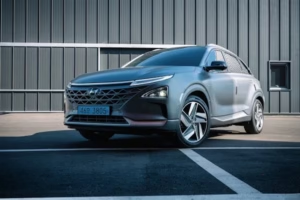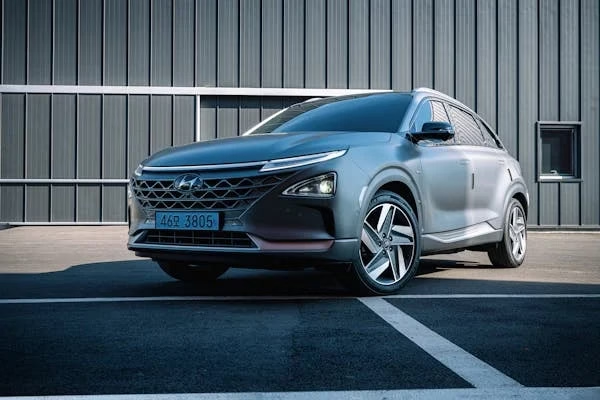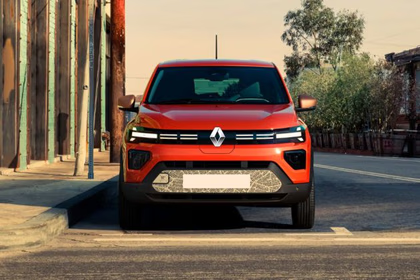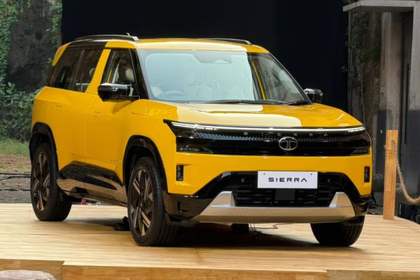Introduction
The motor industry is quickly shifting to cleaner and greener technology, and Hyundai is spearheading the movement with its hydrogen-fueled SUV of the future—the Hyundai Nexo. In a departure from the usual petrol or diesel-powered cars and even those that are electrically powered in the traditional sense, the Nexo is driven by hydrogen fuel cells, giving off nothing more than water vapor as exhaust. It is thus one of the cleanest cars on earth, a vision of things to come in green mobility.
The Hyundai Nexo is expensive, rumored to be priced at Rs. 65 lakh and above. It raises a question: Is it too pricey for the ordinary Indian buyer, or does it justify the cost with its revolutionary technology and the eco-friendliness it promises? This article digs deeper into the facts, comparing the price to the value and questioning whether the Hyundai Nexo is the future India is prepared to accept.

What is the Hyundai Nexo?
The Hyundai Nexo is not only another SUV — it’s a quantum leap in automobile technology as a Fuel Cell Electric Vehicle (FCEV). In contrast to traditional gasoline- or diesel-powered vehicles, or even battery electric vehicles (BEVs) that use only battery-stored electricity, the Nexo employs hydrogen gas to create electricity while in transit.
Fuel Cell Electric Vehicles draw on stored hydrogen in high-pressure tanks along with oxygen in the air to generate electricity via a chemical reaction within a fuel cell stack. This electricity propels the electric motor that turns the vehicle’s wheels. The sole by-product of this operation? Clean water vapor, which makes the Nexo a zero-emission vehicle that emits no harmful pollutants. Internal Combustion Engine (ICE) cars consume fossil fuels, emitting carbon dioxide and other emissions. Battery Electric Vehicles (BEVs) have electricity stored in big batteries. They must be plugged in and charged, usually needing longer breaks to charge fully.
Fuel Cell Electric Vehicles (FCEVs) such as the Nexo generate electricity onboard through hydrogen conversion, leading to quick refueling times (around 5 minutes) and greater driving ranges than with many BEVs. This blend of rapid refueling and long-range tackles two of the most significant limitations currently associated with battery EVs: range anxiety and refueling time.
Expected Price of Hyundai Nexo in India
The Hyundai Nexo is expected to be priced at about Rs. 65 lakh in India.
Electric Vehicles:
- Kia EV6: Priced at Rs. 65.97 lakh (ex-showroom), the EV6 offers a range of 663 km with a 77.4 kWh battery pack and 321 bhp power output.
- BYD Atto 3: Available between Rs. 24.99 lakh and Rs. 33.99 lakh, the Atto 3 has a 60.48 kWh battery and a range of up to 521 km.
- Audi Q5: The Q5 is priced between Rs. 58 lakhs and Rs. 74 lakhs and features a 2.0L TFSI engine.
- Volvo XC60: At Rs. 60.90 lakh, the XC60 boasts a 2.0L B5 diesel motor and mild-hybrid technology, along with an 8-speed automatic transmission.
- Mercedes-Benz GLC: The GLC, which costs between. 58 lakh tons. 74 lakh, ths a 2.0L petrol engine w, 9G-TRONIC automatic gearbox a,nd 4MATIC all-wheel drive.
While Nexo’s hydrogen fuel cell tech provides distinct benefits like zero emissions and fast refueling, it does not have direct rivals in India; hence, it is a niche product in the market.
Breakdown of What You Get at This Price
- Fuel Cell System: The Nexo uses a 1.6L hydrogen fuel cell system, producing 163 PS and 395 Nm of torque.
- Battery Pack: It has a 40 kWh battery, which assists with regenerative braking and holds energy for ancillary systems.
- Range: The Nexo has a range of more than 600 km on the Worldwide Harmonized Light Vehicles Test Procedure (WLTP) cycle, with Hyundai saying that it was able to achieve more than 1,000 km in India under ideal conditions.
- The Nexo features a 12.3-inch touchscreen, and a top-of-the-line audio system.
Key Features and Performance
Hyundai Nexo says that, due to India’s typically less harsh driving conditions, the Nexo may have a range of up to 1000 kilometers on a single hydrogen fill, vastly diminishing range anxiety and making it perfect for extended journeys without having to stop as often.
Whereas traditional electric cars take between 30 minutes (fast charging) and some hours (standard charging) to top up their batteries, the Nexo’s hydrogen fuel tanks can be filled up in about 5 minutes, similar to filling a petrol or diesel car. This fast refueling provides a convenient benefit, particularly for customers who appreciate little downtime and more driving miles without the inconvenience of charging.
The Hyundai Nexo is loaded with high-end amenities that upgrade safety and comfort to a whole new level for fuel-cell SUVs:
- Safety: Lane keeps assist, adaptive cruise control, and park assist make driving safe.
- Comfort: Heated and ventilated leather seats, dual-zone automatic climate control, a panoramic sunroof, and a quiet cabin provide a luxurious and comfortable ride.
- Technology: A 12.3-inch touchscreen infotainment system with Android Auto and Apple CarPlay support, wireless charging, and a premium sound system provides entertainment on the move.
The Hyundai Nexo virtual gauge cluster presents real-time data on hydrogen fuel levels, driving range, and energy usage for efficient monitoring of one’s ride.
The Hydrogen Infrastructure Problem in India
India’s hydrogen fuelling infrastructure remains nascent as of 2024. The nation just launched its first green hydrogen refueling station in Leh, Ladakh, built by Amara Raja Infra for NTPC Ltd. The station generates approximately 80 kilograms of green hydrogen daily and fuels five hydrogen buses in the area. Though this is an important milestone, India is still minimal overall. In comparison to nations such as Japan, South Korea, and Germany, where there are extensive networks of hydrogen refueling stations, India is only now building this infrastructure.
The government of India has seen the need to establish a hydrogen ecosystem. Under the National Green Hydrogen Mission (NGHM), there are efforts to encourage green hydrogen production and hydrogen refueling stations. In March 2025, the government put out plans to deploy 37 hydrogen-powered cross-country vehicles and install nine hydrogen refueling stations under a pilot project under the mission. The huge initial investment for establishing such refueling stations and the low demand for current fuel cell vehicles make private sector investments less desirable. Unless there are firm government incentives and public-private partnerships, hydrogen infrastructure rollout in India might be sluggish and fragmented for a while.
Pros and Cons: Is it Worth the Price?
When evaluating the Hyundai Nexo in India, it deserves its premium price.
- The Nexo emits only water vapor, making it an environmentally friendly vehicle that helps reduce air pollution and carbon footprint. This is a huge advantage in today’s world, which cares about the environment.
- From sophisticated safety features to a premium, tech-heavy interior, the Nexo provides a high-end driving experience complete with modern technology and luxury.
- At a cost expected to exceed Rs. 65 lakh, the Nexo is much pricier than most traditional SUVs and EVs, restricting its appeal to a niche audience.
- The lack of hydrogen fuel stations in India greatly restricts the vehicle’s practical use for daily commutes or long-distance travel.
- Because of its innovative technology and infrastructure issues, the Nexo is now better suited to early adopters and enthusiasts than mass Indian buyers.
Who Should Buy the Hyundai Nexo?
The Hyundai Nexo is ideal for a particular demographic of buyers who can fully take advantage of its sophisticated hydrogen fuel cell technology.
It will mainly appeal to eco-friendly buyers who want zero-emission vehicles and wish to be first in choosing sustainable transportation. In addition, technophiles who enjoy the latest automotive advancements and top-notch features will be very interested in the Nexo. Early adopters—individuals who wish to see the new technology in a vehicle before everyone else does—are also the perfect market for the Nexo today.
Aside from individual consumers, the Nexo has potential in fleets and the government. Its extended range, rapid refueling, and zero-emission capabilities make it a strong candidate for city buses, corporate fleets, or government fleet programs looking to decrease pollution and support clean energy applications.
However, the Nexo is still beyond reach for the average Indian consumer due to its premium price and minimal availability of hydrogen refueling stations. Until the hydrogen network improves and prices are reduced, this car is more a sign of what mobility can be in the future than a reality for the mass market.
Hyundai Nexo vs. Electric SUVs in India
The Hyundai Nexo is positioned in the premium segment with an expected price starting around Rs. 65 lakh, significantly higher than mainstream electric SUVs. For comparison, the Tata Nexon EV costs between Rs. 14 lakh and Rs. 17 lakh, the MG ZS EV between Rs. 22 lakh and Rs. 27 lakh, the BYD Atto 3 approximately Rs. 25-34 lakh, and the Kia EV6 approximately Rs. 66 lakh. This price disparity accounts for the higher hydrogen fuel cell technology and the luxury features provided in the Nexo, but it limits it more for the average purchaser.
The Nexo’s fuel cell system uses hydrogen and delivers a remarkable range of more than 600 km, possibly going up to 1000 km under Indian driving conditions, which is much more than most electric SUVs. Kia EV6 can deliver 500-660 km, BYD Atto 3 can deliver 520 km, MG ZS EV can provide around 419 km, and Tata Nexon EV can deliver about 312 km at full charge.
Infrastructure:
Hyundai Nexo, a niche hydrogen fuel cell car with low infrastructure backing and user density, might struggle with resale value in the Indian market until hydrogen usage becomes widespread.
The Hyundai Nexo leads in range and rapid refueling, providing a cutting-edge alternative to battery electric SUVs. Yet, with its expensive price tag and early-stage hydrogen infrastructure, electric SUVs are currently the more viable and cost-effective option for most Indian consumers.
The Road Ahead: Is India Ready for Hydrogen Cars?
India’s hydrogen vision for a clean energy source is gathering steam, but the journey to mass adoption of hydrogen vehicles such as the Hyundai Nexo is just beginning. The government’s National Green Hydrogen Mission identifies a firm intent to create a green hydrogen economy that could shift India’s transportation and energy industries for the better over the long term.
Pilot programs, including proposals to deploy hydrogen-fueled vehicles and install refueling stations, are essential steps toward developing infrastructure and raising public awareness. Incentives and subsidies for encouraging hydrogen fuel cell technology could also speed up adoption, particularly as the cost of production decreases and infrastructure grows.
Hyundai, being one of the pioneers of fuel cell cars, will likely be a strategic player in India’s future with hydrogen. They can partner with government departments and energy companies to promote infrastructure development and increase the use of hydrogen-powered cars. Having learned lessons from international markets, they are well-positioned to drive the change once the market and infrastructure are electric vehicle ecosystem.
Conclusion
The Hyundai Nexo is a bold, forward-looking leap towards the future of clean mobility in India. Its state-of-the-art hydrogen fuel cell technology gives it remarkable range, quick refueling, and zero emissions, making it significantly ahead of several battery electric vehicles in some points. But this comes at a hefty price and is currently constrained by India’s early-stage hydrogen refueling infrastructure.
For a few environmentally aware early adopters, fleet companies, and government bodies, the Nexo is a good investment and a preview of future sustainable transportation. However, for the typical Indian consumer, it is still too pricey and impractical to use daily.
FAQs
- What is the price expectation of the Hyundai Nexo in India?
The Hyundai Nexo will be priced around Rs. 65 lakh and more, putting it in the luxury SUV premium category.
- In what way is the Hyundai Nexo different from standard electric vehicles?
The Nexo employs hydrogen fuel cell technology, which produces electricity using hydrogen and releasing just water vapor, as opposed to battery electric vehicles that use only battery packs.
- What is the Hyundai Nexo’s driving range?
The Nexo’s driving range is more than 600 km, and it could increase to 1000 km if driven in Indian conditions.
- How long does it take to refuel the Hyundai Nexo?
Refueling the Nexo takes around 5 minutes, which is much quicker than the charging time of most battery-electric vehicles.
- Are there hydrogen fueling stations in India?
Today, India’s hydrogen refueling infrastructure is minimal, and there are just a few pilot stations in places like Leh and Ladakh.
- Is the Hyundai Nexo eco-friendly?
Yes, it emits zero emissions, producing just water vapor, making it a green and clean vehicle.
- Who is the Hyundai Nexo best for?
The Nexo is best suited for eco-friendly customers, tech enthusiasts, early adopters, fleet operators, and government agencies.
- How is the Nexo different from other electric SUVs in India?
Although the Nexo has quicker refueling and greater range, it is much pricier and currently lacks the supporting hydrogen infrastructure of popular electric SUVs.
- What are the biggest challenges to owning a Hyundai Nexo in India?
The initial high cost and the absence of widespread hydrogen refueling stations are the most significant challenges for Indian Nexo owners.
- What is the future trend for hydrogen cars like the Hyundai Nexo in India?
Government programs such as the National Green Hydrogen Mission are set to increase the number of hydrogen vehicles and infrastructure, making them more viable in the future.





